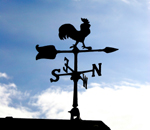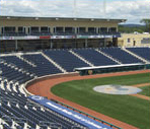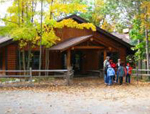Sounding Off: Our Blog
Thoughts, insights, and perspectives on the latest news, trends, and issues regarding architectural acoustics, environmental and industrial noise and vibration, and audiovisual systems design.

Are OSHA Earplugs Enough?
OSHA, The Occupational Safety and Health Administration, has long had policies regulating noise in the workplace. Their “Hearing Conservation Program” is designed to protect workers from suffering hearing loss even if they are subject to loud noise exposures over their entire working lifetimes. But navigating the waters of OSHA’s 1910.95 Noise Exposure Standards document can be a difficult (and daunting) task, and many industrial facilities are happy to outsource this task to the nearest hearing protection salesperson. Unfortunately in this case, ignorance isn’t bliss.

How Weather Affects an Outdoor Noise Study
For many years, I worked as an acoustical consultant in Southern California. We had seasons in SoCal, but it took several years before I easily recognized the subtle differences between summer and fall or between winter and spring. Summer brought daytime temperatures in the 80’s while wintertime temperatures tended to range in the upper 60’s. But for the most part, the temperate climate meant that days would be warm, dry, and sunny and nights would be cooler, dry, and cloudless. My point: long term monitoring of outdoor noise levels and sound propagation was easy.

"You Want the Truth?!?"
“…You can’t handle the truth!” If you’re a movie fan, then you probably recognize this line from the 1992 blockbuster, A Few Good Men. Of course, Nathan R. Jessep (Jack Nicholson) delivered the line in response to Lt. Daniel Kaffee’s (Tom Cruise) questioning in that tense courtroom scene. But in the real world, what happens when a loud outburst like this takes place…in a Courtroom, in a Judge’s Chambers, or in a Jury Room? How is that sound stopped from transmitting into adjacent rooms and hallways? The unfortunate truth is that in many cases, it’s not.

Take Me Out To the Ballpark
Medlar Field at Lubrano Park in State College, Pennsylvania isn’t just the first LEED Certified ballpark in the world – it’s the only one (to date). Known as “The Med”, the new ballpark raises the bar in “green” sports facility design in several areas: water conservation, waste management, and recycled materials. Acoustics By Design first learned of the ballpark’s achievement while attending the MAPPA conference at the Monona Terrace Convention Center designed by Frank Lloyd Wright in Madison, Wisconsin.

Common Tech Team Mishaps
I worked for years in churches as a Technical Director, and during my tenure in that position I had a front row seat on the effects of volunteer-installed equipment. While there is a time and place for volunteers to do some elements of installation, let me say that it’s generally a bad idea. Not because volunteers will always get it wrong, but because volunteers are too valuable to compromise. Here are a few observations/experiences from my years in the trenches.

The Green Buzz
It’s interesting to watch the broader culture around us as it adapts to new ideas and theories. The “Green” concept (the idea that we need to take care of the environment, reduce our carbon footprint, save energy, etc.) really isn’t new at all, but the mounting “buzz” around the word certainly is. When I was growing up, green was nothing more than my favorite color, but now it’s a top story in the news, a popular ad campaign, even a way of life.

Reception Hall Blues
This past spring I was blessed to be married to an amazing woman who thankfully doesn’t mind when I walk into a business and point out the acoustical flaws and potential improvements that could be made “if they had only hired an acoustical consultant!”

Highlights From the AIA Design Retreat at Torch Lake
There are so many retreats going on this time of year, that we at Acoustics By Design were forced to pick and choose which ones to attend. This year, it was the AIA Design Retreat at Torch Lake and the AIA Educational Facilities Planning Conference at Grand Traverse Bay Resort in northern Michigan. This post will highlight the Design Retreat. Think of it as an abbreviated “How I Spent My Summer Vacation” report, but with a lot less photographs and a lot more alcohol.

The Secret Lives of IMAX Theatre Designers
Ask typical movie goers for the definition of an IMAX Theatre, and they will likely give you an unclear response about a big screen and loud sound. On these points they would be right – but only as a vague definition. You see, the IMAX Corporation has gone to great lengths to make sure that every IMAX-certified theatre actually delivers what they consider to be “The IMAX Experience ®.” They want to make sure that the IMAX brand truly means something to consumers – something more than “a big screen and loud sound.” And if that IMAX brand is to mean anything, then every IMAX Theatre must deliver the same high quality movie experience from Los Angeles to New York to your hometown, and so on. This is achieved through the process of IMAX certification, which involves enforcing stringent specifications in two realms: film production and theater design.

The Wailing Industrial Demon Next Door
I am not about to compose a post vilifying the American industrial complex; I’m only expressing the attitude of many people that I come across who live near a noisy factory, processing plant, scrap yard, or other type of industrial facility. Perhaps in some cases, criticism by nearby residents is justified, but usually it is not, and often it is avoidable. Multiple times every year I am called in to assess industrial noise and vibration emissions to residential communities. Often I am hired by the company, sometimes by the local government, and occasionally by a residential group. And by the time I get involved, edgy relations have frequently devolved into contentious confrontations, accusations of purposeful illegalities, and claims of ill health due to noise.